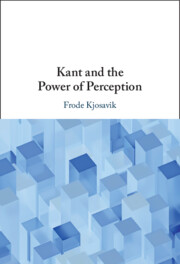Refine search
Actions for selected content:
230 results
Chapter 4 - Wartime Effects
- from Part I - What Is War?
-
-
- Book:
- War and Community in Late Antiquity
- Published online:
- 09 January 2026
- Print publication:
- 31 January 2026, pp 97-116
-
- Chapter
- Export citation
Chapter 3 - Wollstonecraft and Godwin, Loving by the Book
-
- Book:
- Reading Sympathy in Romantic Literature
- Published online:
- 05 January 2026
- Print publication:
- 31 January 2026, pp 101-132
-
- Chapter
- Export citation
Chapter 4 - Fictive Imaginings as Entertainings
-
- Book:
- Truth and Reference in the Making of Fiction
- Published online:
- 18 December 2025
- Print publication:
- 22 January 2026, pp 75-92
-
- Chapter
- Export citation
7 - Imagine to Re-Imagine
- from Part II - Constitutional Law
-
-
- Book:
- Inter-Asian Law
- Published online:
- 16 December 2025
- Print publication:
- 22 January 2026, pp 130-145
-
- Chapter
-
- You have access
- Open access
- HTML
- Export citation
Chapter 5 - Desires and Emotions in Response to Fiction
-
- Book:
- Truth and Reference in the Making of Fiction
- Published online:
- 18 December 2025
- Print publication:
- 22 January 2026, pp 93-110
-
- Chapter
- Export citation
Chapter 5 - Form and Matter in Kant’s Account of Self-Consciousness
-
-
- Book:
- The Aristotelian Kant
- Published online:
- 15 December 2025
- Print publication:
- 22 January 2026, pp 125-147
-
- Chapter
- Export citation
Chapter 1 - What is play?
-
- Book:
- Play in the Early Years
- Published online:
- 12 December 2025
- Print publication:
- 11 December 2025, pp 1-23
-
- Chapter
- Export citation
Chapter 4 - From Perception to Imagination
-
- Book:
- Kant and the Power of Perception
- Published online:
- 27 November 2025
- Print publication:
- 11 December 2025, pp 126-160
-
- Chapter
- Export citation
The biodiversity crisis, the wild and the archaeological imagination
-
- Journal:
- Antiquity , First View
- Published online by Cambridge University Press:
- 10 December 2025, pp. 1-11
-
- Article
-
- You have access
- Open access
- HTML
- Export citation

Kant and the Power of Perception
-
- Published online:
- 27 November 2025
- Print publication:
- 11 December 2025
Maurizio Ferraris lecteur de Kant. Le nouveau réalisme et le renversement de l’architectonique kantienne
-
- Journal:
- Dialogue: Canadian Philosophical Review / Revue canadienne de philosophie , First View
- Published online by Cambridge University Press:
- 26 November 2025, pp. 1-17
-
- Article
-
- You have access
- Open access
- HTML
- Export citation
The Argument from Imagination
-
- Journal:
- Journal of the American Philosophical Association , First View
- Published online by Cambridge University Press:
- 11 November 2025, pp. 1-19
-
- Article
-
- You have access
- Open access
- HTML
- Export citation
1 - Memory and imagination
-
- Book:
- The Prompts You Need to Help You Write the Book You Want to Write
- Published online:
- 25 October 2025
- Print publication:
- 06 November 2025, pp 1-14
-
- Chapter
- Export citation
Introduction
-
- Book:
- Kierkegaard and the Structure of Imagination
- Published online:
- 26 September 2025
- Print publication:
- 16 October 2025, pp 1-20
-
- Chapter
-
- You have access
- HTML
- Export citation
Chapter 11 - Controlled Experiments
- from Part III - Kierkegaard and the Concept of Thought Experiment
-
- Book:
- Kierkegaard and the Structure of Imagination
- Published online:
- 26 September 2025
- Print publication:
- 16 October 2025, pp 176-192
-
- Chapter
- Export citation
Conspiracy Stories
-
- Journal:
- Canadian Journal of Philosophy , FirstView
- Published online by Cambridge University Press:
- 14 October 2025, pp. 1-19
-
- Article
-
- You have access
- Open access
- HTML
- Export citation
Chapter 11 - Leaders, Artists, Innovators
- from Part II - The New Psychology of Intergroup Relations
-
- Book:
- The Psychology of System Change and Resistance to Change
- Published online:
- 23 September 2025
- Print publication:
- 09 October 2025, pp 220-251
-
- Chapter
- Export citation
17 - Liturgy and the Proclamation of the Word
- from Part IV - Liturgy and the Life of the Churches
-
-
- Book:
- The Cambridge Companion to Christian Liturgy
- Published online:
- 19 September 2025
- Print publication:
- 09 October 2025, pp 299-316
-
- Chapter
- Export citation
Chapter 3 - Kant and the Idea of a Language in ‘the Senses’
- from Part I - Linguistic Implications of Kant’s Thought
-
-
- Book:
- Kant on Language
- Published online:
- 19 September 2025
- Print publication:
- 09 October 2025, pp 48-66
-
- Chapter
- Export citation
20 - Christology and Political Theology
- from Part IIIb - Christology and Philosophical Theology
-
-
- Book:
- The Cambridge Companion to Christology
- Published online:
- 15 September 2025
- Print publication:
- 02 October 2025, pp 340-358
-
- Chapter
- Export citation
